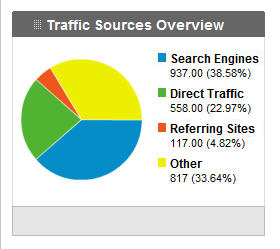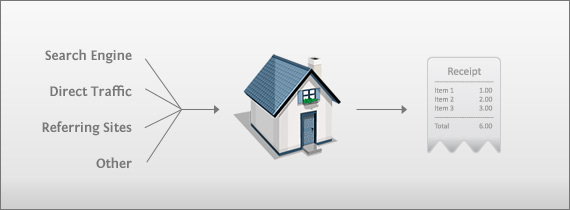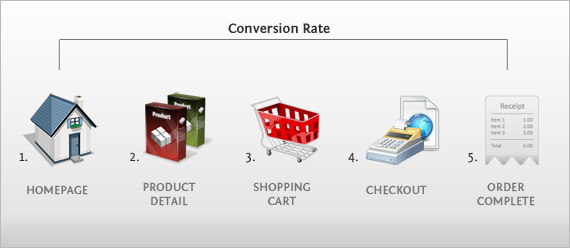Many companies look to macro traffic volume as an indicator of the overall success of their website. However, smart companies are realizing that more traffic doesn’t necessarily mean more revenue, conversion or success. Each website’s traffic is comprised of a variety of unique traffic sources.
Therefore, understanding the sources of your website’s traffic and the impact this traffic has on your conversion rate and revenue are very important. Successful online companies have long realized that it is not the quantity of traffic that converts – it’s the quality.
So, how do you determine which traffic is quality traffic? Here’s four easy steps to help you use your analytics to understand where your traffic is coming from and why it matters:
- Identify traffic sources
- Prioritize based on revenue contribution
- Address issues
- Set a regular review date.
Identify Traffic Sources

Visitors reach your website from four major traffic sources. If you look closely, each source has a story to tell:
- Direct traffic – Visitors who generally know something about your company or products because they care enough to actually type in your Web address or click on a bookmark.
- Search engines – Visitors arrive from search engines in two ways:
- Organic links (Google, Yahoo, Bing, etc.)
- Paid links (Google AdWords & AdSense, Yahoo Overture)
Search engines have been widely thought of as the “Holy Grail” of traffic with reports suggesting anywhere up to 80 percent of Web browsing starts at the search engine.
- Referring sites – Visitors who use links from other websites, blogs, affiliates, Facebook, etc. to get to your site. Knowing who is sending you traffic is a great way to identify business opportunities. Look for the reasons a site is directing traffic to you. In some cases, you might not want the traffic. Without checking traffic statistics, you will never know.
- Other – Email campaigns or direct marketing links fall in this category.
It’s important to evaluate these traffic sources as four individual groups, and also evaluate the components of each group individually. Remember, not all traffic is equal!

Prioritize Based On Revenue Contributions
Because a high conversion rate can be deceiving, especially if it is not generating a large percentage of your revenue, be sure to start your analysis by ranking each traffic source according to the revenue contributed. Look at each source based on the percentage of revenue generated or the revenue per visit.
Follow the Pareto Principle as a rule of thumb by looking at the traffic sources that are making up around 80 percent of your revenue. The reason is simple: the higher percentage of revenue a traffic source is bringing in means the more likely a small conversion increase will improve your bottom line.
Don’t spend time looking at a traffic source with a 50 percent conversion rate if it is only bringing in a small percentage of the revenue and a few sales per month. You will need more time to generate statistically relevant data for those low revenue traffic sources.
In order to fully understand the impact that each of these sources has on your revenue and conversion rate, you need to do two things:
- Correctly identify all the pages in your conversion rate calculation process and properly name them in your analytics program. Full sales funnel tracking from all sources is vital to understanding which traffic source is more valuable than another. Choose how you want to calculate the conversion rate and stay consistent! An earlier blog post discusses this topic.

- Add a tracking parameter to each of your inbound links so you will be able to specifically identify the traffic source after a sale. Once you have added tracking parameters to your links, looking at the conversion rate for each source within your analytics program will be much easier.
Address Issues
A bit of trial and error is necessary to identify solutions to the issues that you see, but here’s an example of how utilizing a quality A/B testing solution can be worth it’s weight in gold.
Begin with the top three sources based on your revenue ranking. Look for pages within your website where visitors exit, the bounce rate for these pages and the bounce rate for keywords visitors used to find you in the search engines.
Understanding where visitors left your website gives you a starting point to make changes. Read your page content, does the information you provide make sense from a visitor’s perspective? Click through the site work-flow, is it easy to get the information you need or does it seem that visitors could become lost or confused while trying to checkout?
If you find that visitors are leaving from your cart or checkout pages, set up an A/B test with some slight changes. This will help you isolate the issue and increase your conversions and revenue. Once you have finished with your top revenue traffic sources, put your attention to the sources that have decent conversion rates but don’t generate as much revenue.
It is always helpful to do a quick analysis of the best converting traffic sources that are not bringing in much revenue because they might need just a little help to become a viable and profitable revenue stream.
Set A Regular Review Date
This whole review process should be performed at least quarterly, as this will truly help to optimize your site traffic and ultimately your bottom line. There is no doubt that this analysis takes time and practice to complete but once you have seen the benefits this will become part of your company’s “Best Practice” routine.
Keystone
Create a methodology to analyze your site’s traffic and conversion rates. By focusing on the the highest traffic sources, you can optimize conversion rates and increase your revenue. Not all traffic is equal!
Have you implemented a structured process, followed it regularly and seen success? What were some of those “a-ha!” moments when a minor change resulted in major increases?
Chris Hamill contributed to this blog post.
Great post. Adding tracking parameters is one of the most valuable to actually see the last marketing touch before a person checks out. I use the x-parameter to measure ALL of my marketing efforts and it has given me great insight into where I should be spending my efforts and where are opportunities to make additional incremental revenue.
Thanks Neil.
You mentioned using x-parameters before entering the cart, but how do you track the person all the way to the source, especially when the source doesn’t go directly to the cart? It’s important that you can carry tracking information through your website and landing pages to the conversion point or else you aren’t getting the full picture.
And if you have suggested topics for future blog posts, visit our Facebook page to post suggestions: http://www.facebook.com/pages/Building-Keystones/153683638001551?v=app_2373072738
Cheers,
craig.
http://twitter.com/buildkeystones
I use the x-parameter tracking at the source by creating a link that drops a cookie right from the get go and then redirects to a specific landing page. This allows me to track all the way from the source – PPC, Email, General Advertising, Other Promos – to the conversion. I hope that makes sense.
Good Morning,
I have some questions regarding the Pareto principle. The principle as you mentioned states “look at the traffic sources that are making up around 80 percent of your revenue. The reason is simple: the higher percentage of revenue a traffic source is bringing in means the more likely a small conversion increase will improve your bottom line.”
What if the area where 80% of the revenue generated is only 3% of the total traffic coming to your site? Does this principle still hold true and, if so, could you elaborate why? When I think about it in this sense the Pareto principle doesn’t add up. If this were the case, I would be more tempted to optimize on the 97% of the traffic that is not converting. To put 97% in perspective, consider a website that has 1 million unique visitors every month.
Regards,
KC
Hi KC,
I kind of see your point here, however I think it is important to consider the level of investment (both time investment and fiscal investment) required to increase the conversion rates for a specific traffic source.
If a 10% conversion rate increase can be achieved with a similar effort for both the high-revenue and the low-revenue channels, a company would see a better return on their investment by focusing on the high-revenue channels.
However, it seems that depreciating returns do exist in the world of channel optimization. It may be likely that your high-revenue traffic has already approached a conversion rate limit, and that additional optimization efforts would be better focused on the lower-revenue, lower-conversion channels. Therefore it is important for companies to do a cost/benefit analysis for each traffic source when preparing channel optimization strategies.
Cheers,
Andy
Hi Craig,
The aha-moment came when I ditched bounce rate in this scenario and looked at exit rates in funnels. Generally these two are tricky metrics as they produce deceiving averages and mean completely different things. Everyone has to exit a site at a certain point or most likely time. So exit rates really don’t matter unless you look at a defined funnel (i.e basket to thank-you). Bounce rates should only matter when you check your landing pages. Then the dissection of traffic source makes sense as you can then potentially identify why you get such a high bounce rate of these (misleading PPC ad, crap ad-copy, lost scent, etc). But again, be weary of these. A 100% bounce rate from mysuperlinkbuildingsitethatinstalltstrojans.com might not be too bad if it is only 3 visitors.
In General though I fully agree with the principles discussed here, 80% rule. It will be much easier to show your senior management you did something great if you improve something that makes it onto the dashboard report than increasing the revenue of a tiny referral by 1000%
I tend to run A/B test initially though with drastic changes. The danger is that if the change is too subtle you won’t see any improvement and management will say “screw testing”. So rather than changing the hover state of a button, change the whole lot and test a much bolder change. Yes we all look for (and read about) the million dollar button change. Chances are your business doesn’t make enough of those dollars to actually produce something like that and you will probably make more money improving your site overall.
Hey David,
Thanks for your post. While the Ah-Ha moments are rare, we hardly ever forget them.
I agree with your comment “Bounce rates should only matter when you check your landing pages” to a point as I have seen cases where due to the structure of the website itself, the bounce rate can become very important upstream of the landing page, especially when customers exit because they can not navigate to the landing page.
Also, in regards to using drastic changes in your A/B tests, I thought you might find this blog I read from the Performable Web Analytics blog earlier this summer interesting.
http://bit.ly/htd90P
I think their blog post really sums up the fact that unless you have very significant volume, incremental testing just might not be the way to go. Testing two completely different pages might show you results in weeks that would take months if you did them one at a time.
Look forward to seeing more posts from you on more of our blogs.
Take care,
Chris